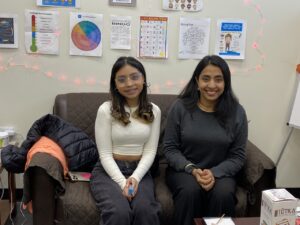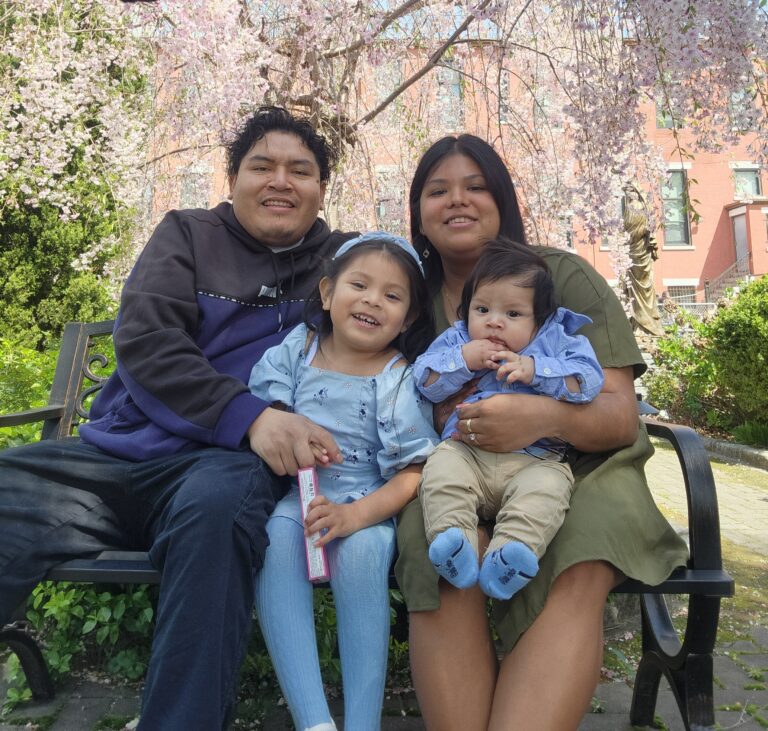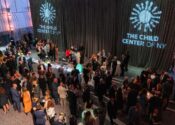By Linda Rodriguez, SVP, Behavioral Health, Early Childhood, and Community Partnerships

A photo of Governor Kathy Hochul announcing her mental health plan, taken by the blog author
As a multiservice organization that provides mental health treatment and support to young New Yorkers, before March 2020 we were busy, serving more than 40,000 New Yorkers annually through our behavioral health, early childhood education, youth development, and other programs across the city. Since then, the intensity of our work has profoundly escalated. It’s no secret that the disruption children experienced during the peak phases of the COVID-19 pandemic created an avalanche of mental health challenges that, in many ways, we are only beginning to fully understand. While many questions remain, we know one thing for sure: in our 70 years of this work, we have never seen the severity of anxiety and depression across age groups as we do today. The numbers tell an alarming story, reflecting what we see every day: citywide, one in five New Yorkers is experiencing mental illness.
If there’s any silver lining, it’s that from school staff to parents to policymakers, New Yorkers recognize the need to expand mental health services. Early this year, Governor Hochul released a plan to do exactly that, overhauling the state’s continuum of mental health care. I was honored to attend the announcement event. Now, as we wait for the state budget to be finalized and we kick off Mental Health Awareness Month, I want to share The Child Center’s insight into which parts of Governor Hochul’s plan will truly move the needle on mental health, as well as recommendations for what we would like future strategies to consider.

Daniela and her therapist, Sarah Rashid, LMSW
First, we strongly support the governor’s plan to allocate resources dedicated to high-acuity cases—youth with severe mental health conditions, and who are suffering from the aftermath of trauma. Consider our client Daniela, who developed PTSD upon returning to in-person school and required intensive treatment to become the healthier, happier student she is today. We encounter more and more Danielas all over the city. Hochul’s plan reflects this increase in high-risk, high-need cases and includes funding for intensive outpatient programs, such as her funding of innovative Youth Assertive Community Treatment teams.
Next, it’s critical to invest in the behavioral health workforce or else, as the NYS Coalition for Children’s Behavioral Health put it, we “risk watching the best intentions result in no meaningful change.” Many clinicians want to do this work. But the salary we can offer is not up to par with the care and work these clinicians provide, and what they could get elsewhere. This is especially true for bilingual and bicultural therapists, who are desperately needed across the board. We’ve had an opening for a school-based clinical coordinator at Flushing High School since September but have been unable to fill it largely because the salary was only $60-65K. We’ve increased it to $66-70K with a $3K sign-on bonus, and still no takers. Mental health plans must include more funding to attract culturally competent candidates who can best serve low-income populations.
We also must prioritize paying all our mental health workers a livable wage. This is a city issue as well as a state issue.
Last month, the City Council released its preliminary budget, which includes $60 million to fund a cost-of-living adjustment (COLA) for nonprofit human services workers. While we thank the Council for recognizing that last year’s $60 million investment was insufficient, this year’s allocation of an additional $60 million falls short of the $200 million necessary for the 6.5% COLA the sector deserves. With cost of living continuing to rise, this is the least we can do for our dedicated human services workers.
This week, Mayor Adams released the City’s executive budget. Sadly, it contains no COLA for human services workers at all. We are deeply, profoundly disappointed at the mayor’s lack of recognition for our human services workforce and will do everything we can to advocate for a 6.5% COLA in the final budget.
In addition to paying the current workforce fairly, both city and state should fund improved professional recruitment and training in order to increase the number of qualified people in the field. Future mental health plans should include incentives for young adults from BIPOC and immigrant communities to pursue mental health careers and community-based work: think loan forgiveness, tuition support, and speaking in schools about the rewards of this career path.
Third, we were extremely pleased that the governor’s plan included a robust commitment to funding school-based mental health (SBMH). There is no question that this is a vital part of meeting the mental health needs of youth, as the CDC’s recently released Youth Risk Behavior Survey makes clear.
Our concern is with how those funds will get channeled. SBMH wellness centers “live” in schools, but they are staffed by community-based organizations (CBOs) like The Child Center. Funding should be provided directly to the CBOs as opposed to allocating resources strictly to the DOE. That’s because CBOs can best determine the most effective way to meet the most urgent needs—for example, by increasing the salary of an open position for a therapist. In addition, CBOs can offer more flexibility to meet each student’s and family’s needs. Some children may be best served in school, but others may be better served at home, in the community, or via tele-health. For example, children are better served in their school when they live in a small apartment where they can’t talk freely with their therapist via tele-health, or when the parent works multiple jobs and it isn’t practical for them to take the child to a community wellness center; a school setting in these cases is more convenient. In other cases, a community-based wellness center may better meet children’s needs—for example, in a family in which the children attend different schools but the whole family needs therapy. The Child Center offers all four options (school, home, community, and tele-health), and by funding us directly, we can offer whatever works best for each family. If the DOE is funded directly, therapy in the school is the only option.
Finally, both city and state need to thoughtfully direct resources beyond mental health, to the core services that can address sources of stress that lead to crisis for families and children. Governor Hochul has clearly and strongly articulated support for additional funding for housing and vocational training, showing she understands we can’t expect to solve the mental health crisis without addressing underlying factors like the lack of affordable housing, or the inability to find a job that can sustain a family.
We believe in the governor’s commitment to real progress, and we share these perspectives simply because we want to make sure that if big change is coming, it’s coming the right way.
Like so many of our fellow service providers, we are standing by to partner with the governor on this ambitious and necessary work. We thank Governor Hochul for rising to challenges as they come and her commitment to meeting them in ways that benefit New Yorkers facing mental health challenges—which include so many of us. This is the best way we can truly honor the spirit of Mental Health Awareness Month and, more important, our sacred responsibility to guide our children and families into a happy healthy future.






